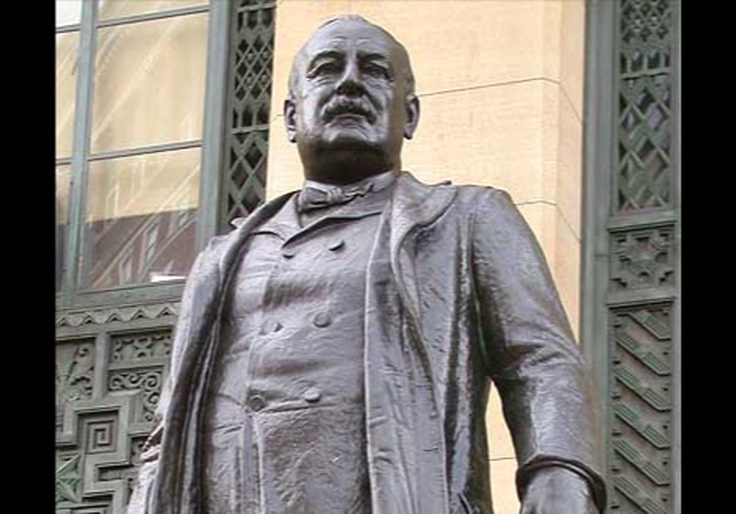Only 14 men have served two full terms as president of the United States. Of those 14, Grover Cleveland is perhaps the least well-known. Which is odd. Our two-term chief executives are some of the most famous presidents: George Washington, Thomas Jefferson, Andrew Jackson, Franklin Roosevelt, and Ronald Reagan. But all of them are fairly familiar to the general educated reader. Grover Cleveland, in contrast, falls in the category of the mostly forgotten facial-hair-presidents-of-the-late-19th century.
Cleveland is so unknown that he doesn't have a monument or even a statue in Washington. He does merit one (so far) untouched claim to fame: In contrast to the other members of the two-term club, his service was nonconsecutive. Cleveland exited his first term after a close defeat to Benjamin Harrison. He then turned around and beat Harrison in the next election. He returned to the White House, making him one of only three presidents, along with Jackson and Roosevelt, to win the popular vote at least three times. Upon leaving the White House the first time, Cleveland's wife Frances declared, "We are coming back just four years from today."
Troy Senik's new biography of Cleveland, A Man of Iron, shows that Cleveland is unappreciated. Senik, a former White House speechwriter and conservative think tanker, admired Cleveland from a young age, visiting the president's birthplace when he was 16. Senik has good reason to admire Cleveland, as the book shows. Cleveland had a fascinating backstory. Born into poverty, he had one of the most meteoric rises to the presidency, moving from mayor of Buffalo to governor of New York to president in a few short years. Perhaps Theodore Roosevelt—also from New York—is the only president to rival the rapidity of Cleveland's rise. Cleveland also had a sex scandal, fathering a child out of wedlock, yet still managed to get elected. And he had a medical scandal, sneaking off while in the White House to have a secret surgery on a cancerous growth in his mouth. Surgery took place on a boat and the president was somehow able to keep it mostly under wraps until years after his death.
Cleveland also dealt with a fascinating issue set, although the issues, including tariffs, military pensions, and free silver, may lack resonance today. He was a big believer in the Constitution and took pains to make sure that his actions remained within the constraints of that document. When Congress passed disaster relief for drought-stricken farmers, he vetoed it because such an action was not accounted for in the Constitution. He was a workaholic who took the job seriously. And he stands in stark contrast not only to our current president, who has found a way to have the executive branch forgive student loans. Sadly, Cleveland's self-discipline and adherence to principle are markedly different from most of his successors.
In his most fascinating chapter, Senik looks at the question of why Cleveland is so little remembered today. One reason is that lack of resonance of the key issues of his time, which makes it hard to place Cleveland in the context of current political debates. Cleveland also gave boring speeches, some lifted from the encyclopedia, in a high-pitched nasal voice. He also could have run for a third term, which would have made him better known to us, but chose not to. Later, his wife Frances, who long outlived him—Cleveland died in 1908—refused to vote for Franklin Roosevelt's third term in 1940, citing Cleveland's example to her children: "Your father never approved of a third term." However, when FDR ran again in 1944, she told her children that was okay to support him, saying, "Your father never said anything about a fourth term." Cleveland also presided over a painful economic depression, something that often harms the reputation of presidents who preside over them.
But the main problem Cleveland faces in the quest for historical recognitions is that he was a limited-government conservative who opposed government economic interventions, making him a Democrat of a mold that went away with the advent of the progressive Woodrow Wilson. Cleveland, as Senik shows, actually recognized Wilson's potential when Wilson was at Princeton, but then broke from him as his presidency moved in a decidedly non-Clevelandian direction.
In this, Cleveland has become an uncomfortable forebear for today's Democrats in his fealty to constitutional limits and his belief in small government. Republicans are unlikely to celebrate a Democrat, all Democrats are unlikely to celebrate this kind of Democrat, leaving Cleveland largely out in the cold. Regardless, though, Americans of all stripes should celebrate this patriotic and dedicated public servant who ably steered our nation through both challenging and exciting times.
A Man of Iron: The Turbulent Life and Improbable Presidency of Grover Cleveland
by Troy Senik
Threshold Editions, 384 pp., $32.99
Tevi Troy is a senior fellow at the Bipartisan Policy Center and a former senior White House aide. His latest book is Fight House: Rivalries in the White House from Truman to Trump.
